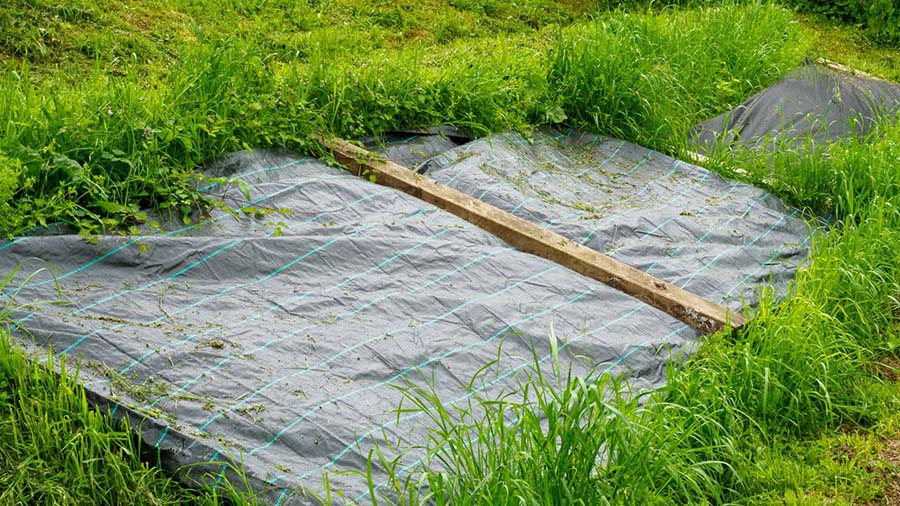Creating Weed-Free Zones From Veggie Patches to Flower Beds
One of the most common uses of woven landscape fabric is creating weed-free zones in your garden or landscaping. No matter your vision, this fabric can be your best friend in keeping invasive growth at bay.
The process is straightforward and can significantly reduce the time spent weeding. With proper preparation and installation, you’ll have a long-lasting barrier that prevents weeds from emerging and competing with your cultivated plants.
Try This: Laying Woven Landscape Fabric in a Small Garden Bed
Let’s get a small section of your garden ready for a weed-free future:
- Select a small flower bed or vegetable patch (about 3 feet by 3 feet is a good starting size).
- Remove all visible weeds from this area, making sure to get the roots if possible.
- Rake the surface lightly to create a relatively even area.
- Cut a piece of woven landscape fabric slightly larger than your prepared bed (e.g., 4 feet by 4 feet).
- Lay the fabric over the bed, ensuring it covers the entire area. Use garden staples to secure the edges of the fabric to the ground, spacing them about every foot. Pull the fabric gently taut as you go.
Observe this small section over the next few weeks. Notice how the fabric prevents new weeds from emerging in the covered area compared to any uncovered parts of your garden. This hands-on experience will give you a tangible understanding of how effective woven landscape fabric can be in creating dedicated weed-free zones.
Stabilizing Paths and Patios: Building Walkways That Last.
Beyond keeping garden beds weed-free, woven landscape fabric is also invaluable for creating stable and long-lasting pathways and patios. It provides a crucial layer of separation and reinforcement when used as an underlayment beneath gravel, stepping stones, or paving blocks.
Without a stabilizing layer, the materials used for your paths and patios can gradually sink into the soil below, shift over time, and become uneven. Weeds can also push through the gaps, disrupting the appearance and requiring ongoing maintenance. Woven landscape fabric helps to prevent these issues by providing a strong, stable base that distributes weight, inhibits weed growth from below, and prevents the mixing of the top layer with the underlying soil. This results in a more durable and attractive walkway or patio that requires less upkeep.
Try This: Simple Tips for Laying Woven Fabric Under a Path
If you’re planning a new gravel path or refreshing an existing one, here’s a few simple tips for incorporating woven landscape fabric:
- Remove any existing vegetation, rocks, and loose debris from the area where you plan to lay your path. Level the soil as much as possible.
- Lay down a layer of woven landscape fabric over the prepared path area. Make sure it extends slightly beyond the path’s intended edges.
- Use garden staples along the edges of the fabric to hold it in place.
- Now, spread your gravel, stepping stones, or other chosen path material directly over the fabric. The fabric will act as a barrier, preventing the gravel from sinking into the soil and inhibiting weeds from growing through it.
Even this simple application demonstrates how woven landscape fabric can make a walkway more stable and weed-free.
Taming Slopes and Preventing Erosion.
Erosion can be a significant challenge for gardeners dealing with sloped terrain. Rainwater runoff can wash away valuable topsoil, leaving behind barren patches and carrying sediment into other garden areas. Woven landscape fabric can be a surprisingly effective tool in combating soil erosion on inclines.
When properly installed on a slope, the fabric helps hold the soil in place by reducing the direct impact of raindrops on the soil surface, slowing down runoff, and allowing water to gently filter into the ground rather than washing away the top layer. The fabric’s strength also provides a degree of reinforcement to the soil structure, further preventing movement.
This is particularly beneficial for newly planted slopes or areas where you’re trying to establish ground cover. By stabilizing the soil, woven landscape fabric gives your plants a better chance to take root and eventually provide their own natural erosion control.
Try This: A Small-Scale Erosion Control Application
Here’s a simple way to see how woven landscape fabric can help with erosion on a small slope in your yard:
- Find a small, gently sloping area in your garden or yard where you’ve noticed soil erosion after rain.
- Clear any loose debris or vegetation from the slope.
- Cut a piece of woven landscape fabric large enough to cover the sloped area, with a little extra at the top and bottom to anchor it.
- Dig a small trench (a few inches deep) at the top of the slope. Lay the top edge of the fabric into the trench, and then backfill the soil to anchor it.
- Carefully unroll the fabric down the slope, smoothing out any wrinkles.
- Use garden staples to secure the fabric along the slope, spacing them every foot or so. Pay extra attention to securing the bottom edge of the fabric.
After the next significant rainfall, observe the treated slope compared to any similar untreated slopes in your yard. You should notice significantly less soil runoff from the area covered with the woven landscape fabric.
Choosing the Right Color for Your Garden
You might notice that woven landscape fabric is commonly available in black or white. While the fundamental weed-blocking and durability properties are similar, the choice of color can have a subtle impact on your garden:
Black Woven Landscape Fabric
This is the most common choice and excels at blocking sunlight, effectively suppressing most weeds. Black fabric also absorbs heat from the sun and warms the soil slightly, which can be beneficial in cooler climates or for heat-loving plants.
White Woven Landscape Fabric
White fabric reflects sunlight, which can help keep the soil cooler in hot climates. This can be advantageous for plants that prefer cooler root temperatures. Additionally, the reflective surface can sometimes increase the amount of light reaching the lower leaves of plants.
Black woven landscape fabric is an excellent and versatile choice for most general gardening applications focused on weed control. Consider white fabric if you are gardening in a hot climate and are concerned about excessive soil warming.
Looking Ahead
Now that you’ve seen how versatile woven landscape fabric can be in your garden, you’re probably eager to get started on your own garden. The next chapter outlines a step-by-step guide for measuring and installing your woven landscape fabric for long-term service. Get ready to learn the practical techniques for successfully implementing this powerful gardening tool!




